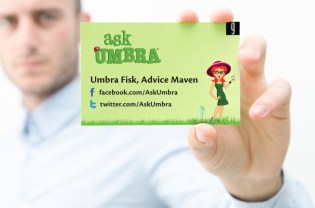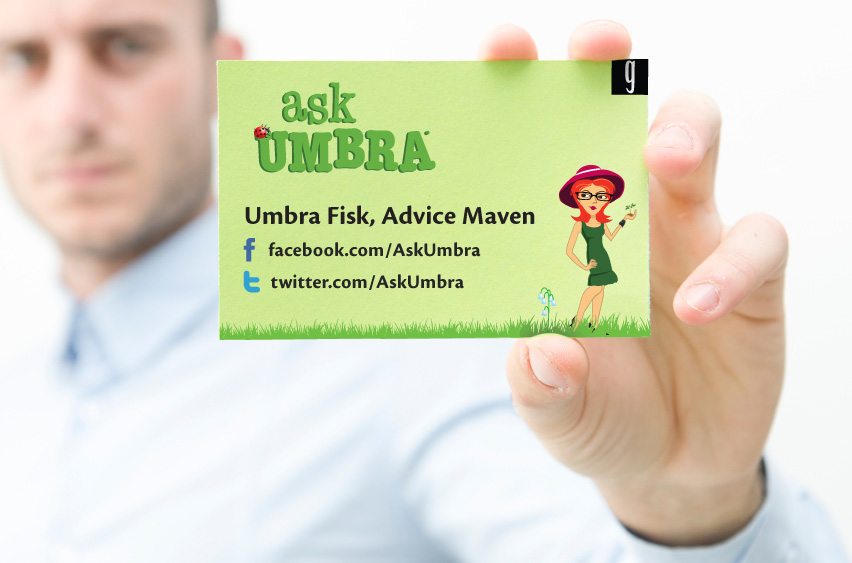Send your question to Umbra!
Q. Dear Umbra,
How can I get “free,” “environmentally” friendly business cards? I am starting to network with my new credentials, LEED GA and BPI certification. So I need an eye-catching business card.
Dee R.
Philadelphia, Pa.
 A. Dearest Dee,
A. Dearest Dee,
First of all, congratulations. For those who don’t speak eco-acronym, Dee here has become something of a green-building expert, proving her chops as both a LEED Green Associate — someone with expertise in environmentally friendly construction and design — and a Building Performance Institute professional, chock-full of knowledge about home energy performance and efficiency. Go Dee!
Given your new credentials, it’s logical that you want to share them with all and sundry. As a people, we have been thrusting business cards into each others’ hands since the 17th century, when English merchants used them to give customers accurate directions to their stores. The trend caught on in America in the late 1800s, and the rest is 2-by-3.5-inch history.
Personally, I am not a big fan of the business card, and rarely hand mine out at cocktail-weenie hour. Environmentally, I don’t believe distributing small pieces of paper to people who will toss them or let them stack up on a desk does much for our cause. One estimate suggests more than 10 billion cards are printed each year. Laid end to end, that’s … a whole lot of business cards.
Eco-impact aside, the dawn of the digital era has led to passionate arguments about whether the business card is dead. Here is just one debate on said topic. The general consensus seems to be, “Nope, and it won’t be any time soon, but some interesting alternatives are cropping up.” Let’s have a look at some of your options.
- If you order paper cards, go green. Should you decide to shell out for traditional cards, search “eco business cards” or a similar phrase and you will find plenty of companies offering recycled paper, soy- and other vegetable-based inks, and friendly eco-couriers who will bicycle your shipment to Philadelphia. Well, I can’t guarantee that last part. I also cannot guarantee the performance of particular companies, but it seems that crowd favorites in this area include GreenerPrinter.com and Moo.com. Here’s a green-printing primer for sifting through the various issues and claims.
- If you order paper cards, go tiny. Some printers now offer “mini-cards,” whose dimensions are closer to 1-by-3 … thus using less than half the paper! Depending on whom you ask, these eensy cards either make a huge impact or are immediately lost. The other drawback here is that no company I found seemed to offer these cards on recycled stock, although the aforementioned Moo.com uses sustainably sourced stock. In this case, I think bigger might be better.
- Make your own. It seems counterintuitive: Do I want my professional card to look like a third-grade art project? But here is where your need for “free” and “environmental” might be best met, and the results can be quite handsome. Here’s the idea: Get a rubber stamp custom-made with your personal information, logo, and what have you. Then find the recycled or reclaimed paper of your choice to stamp it on, and voila. Such a stamp will probably run you a one-time cost of $50-$60; check out Etsy or this handy list. You could also design and print your own cards at home or a local print shop, maintaining control over the type of paper and — this is key — printing only as many as you need.
- Give them something else to remember you by. Could you give potential clients some other token? Grist once made branded eco-toothbrushes. This list suggests seed packets, clothespins, and peanut shells as ersatz calling cards. Perhaps there’s something out there that reflects your interests and is affordable, easy to carry, and light on the planet.
- Go digital. This option is free and saves paper, but assumes you and your potential clients are tech-savvy. Schmoozy possibilities include mobile-to-mobile sharing using an app such as Bump or CardCloud; creation and sharing of virtual cards through a service like TwtBzCard; or even personalized QR codes. By the way, if you’re on the receiving end of too many paper cards, apps such as Google Goggles and CardMunch can help you digitize them.
Remember, Dee, a business card is not akin to confetti, to be showered upon everyone you meet. Doling yours out to people who really want them is another crucial way to use resources wisely.
Good luck in your new line of work — can’t wait to see your card.
Industriously,
Umbra




